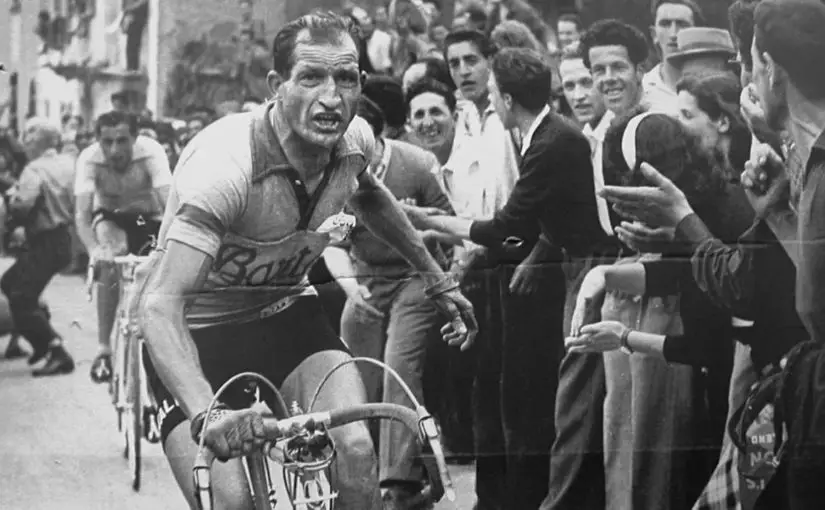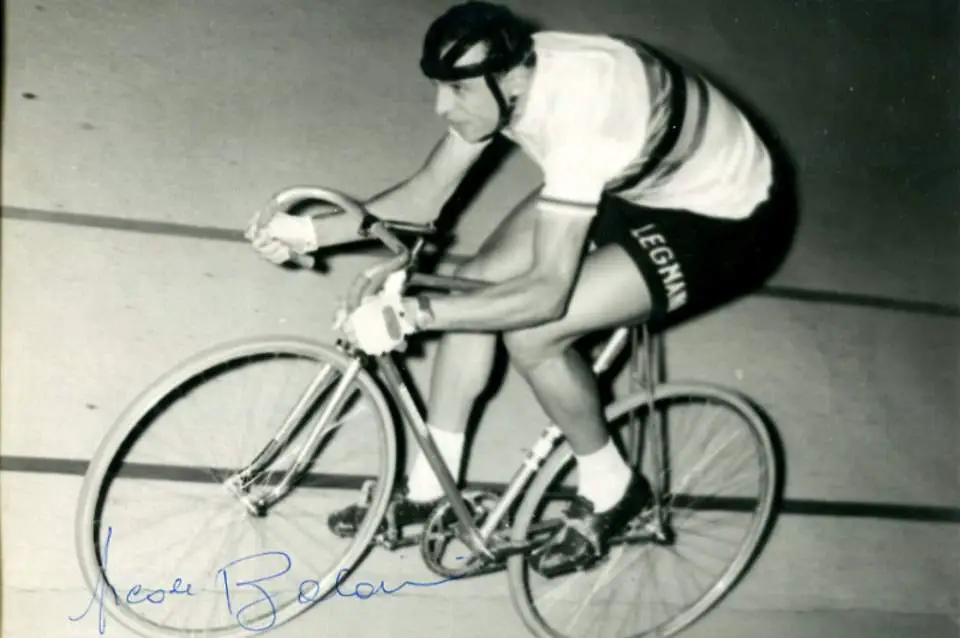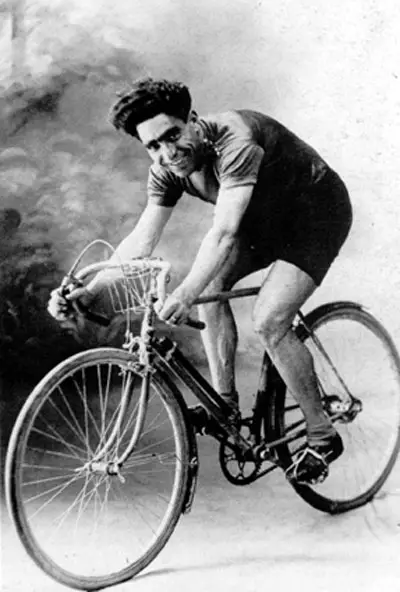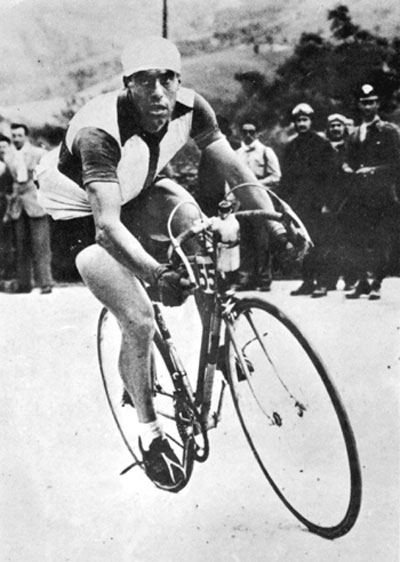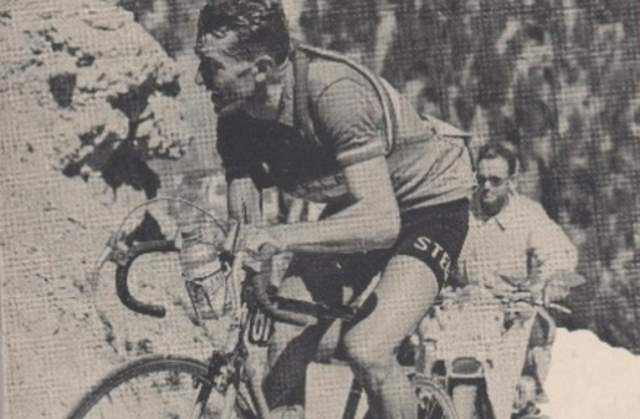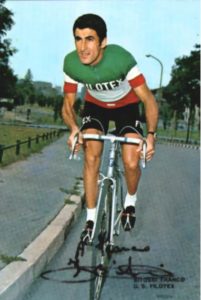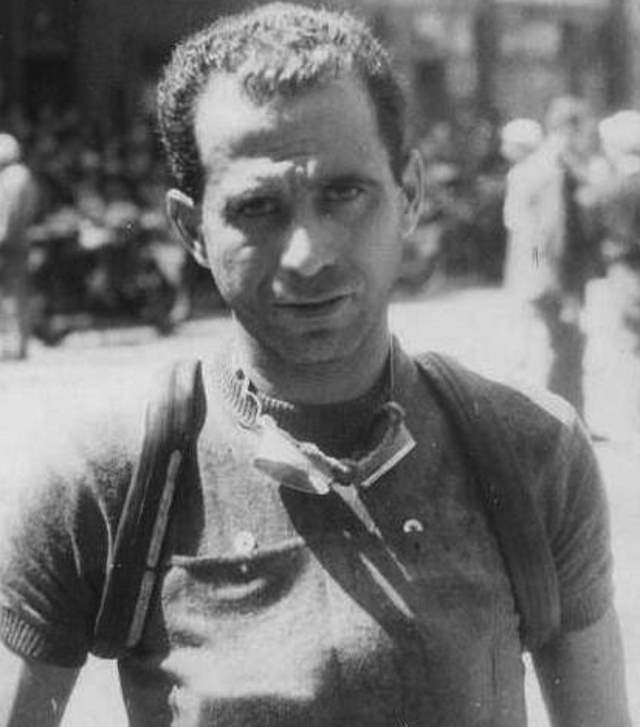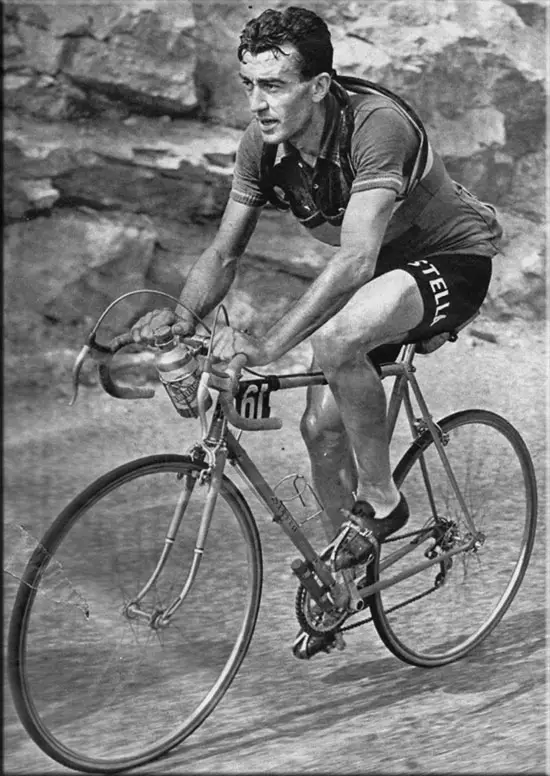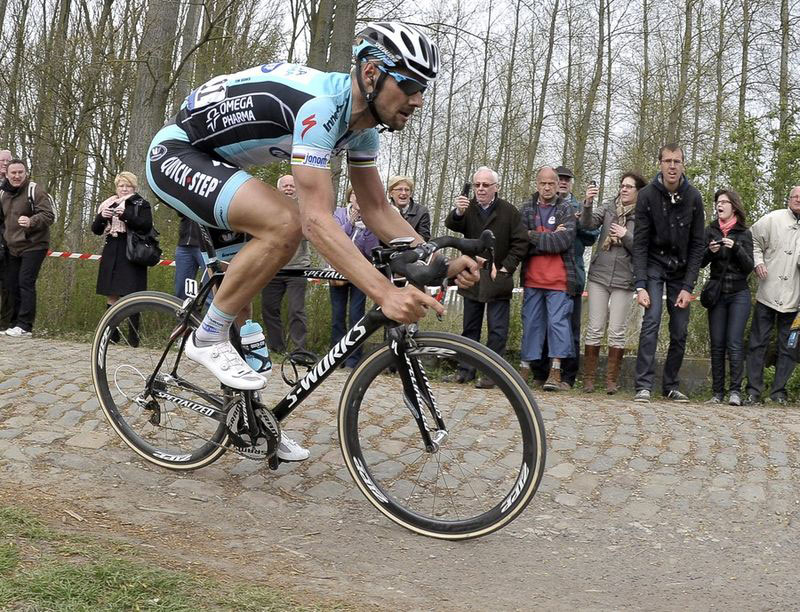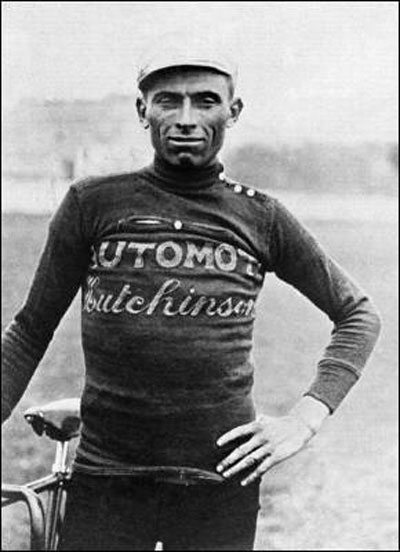Early 20th journalists started creating nicknames for the cyclists. This effort popularized the cycling sport and make the racers interesting to the people who were not interested in cycling much. This tradition is still continuing today. Here the list of cyclists’ nicknames in alphabetical order (by surname, starting with B):
By Surname: A B C D E F G H I J K L M N O P Q R S T U V W
Federico Bahamontes
“The Eagle of Toledo”
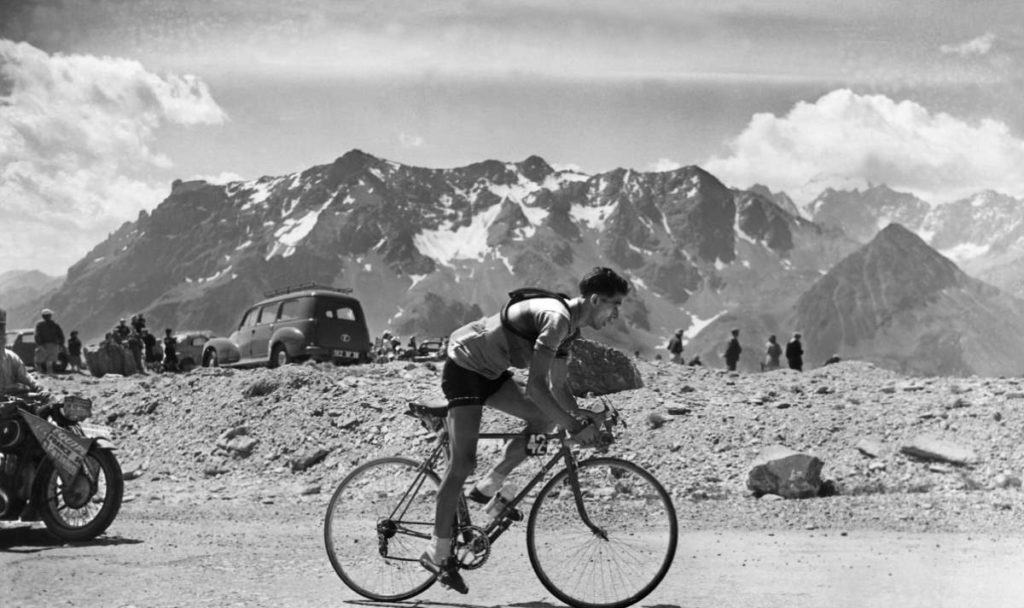
Federico Martín Bahamontes (born 9 July 1928) is a Spanish former professional road racing cyclist. Born as Alejandro Martín Bahamontes. He is the first cyclist to complete a “career triple” in winning the “King of the Mountains” classification in all three Grand Tours. He is the first Spanish winner of the Tour de France (1959). He won the mountains classification of the Tour six times (1954, 1958, 1959, 1962, 1963, 1964) with 7 individual stages (1954-1965). He was so superior at climbing that the reporters gave the nickname the “Eagle of Toledo”.
Ercole Baldini
“Direttissima di Forli” (English: “The Fast Train from Forli”)
Ercole Baldini (born 26 January 1933) is a retired Italian cyclist. As an amateur he won an Olympic gold medal in the road race and the world title in the individual pursuit on track, both in 1956. Next year he turned professional, and in 1958 won the world title in the road race and the Giro d’Italia. He continued competing on track and won bronze medals in the individual pursuit at the world championships of 1960 and 1964.
[adpost]
Gino Bartali
“Gino the Pious”, “Ginettaccio”, L’uomo di ferro” (English: The Man of Iron)

Gino Bartali (18 July 1914 – 5 May 2000) was the most renowned Italian cyclist before the Second World War, having won the Giro d’Italia three times (1936, 1937, 1946) with 17 individual stages and the Tour de France twice, in 1938 and 1948, with twelve individual stages.
His second and last Tour de France victory in 1948 gave him the largest gap between victories in the race, which still remains. He also won Milan-Sanremo four times, Giro di Lombardia (today Il Lombardia) three times, became the Italian champion four times (first in 1935 and the last one was in 1952!), Giro d’Italia mountains classification seven times, Tour de France mountains classification twice, among with many other important stage races and one-day classics.
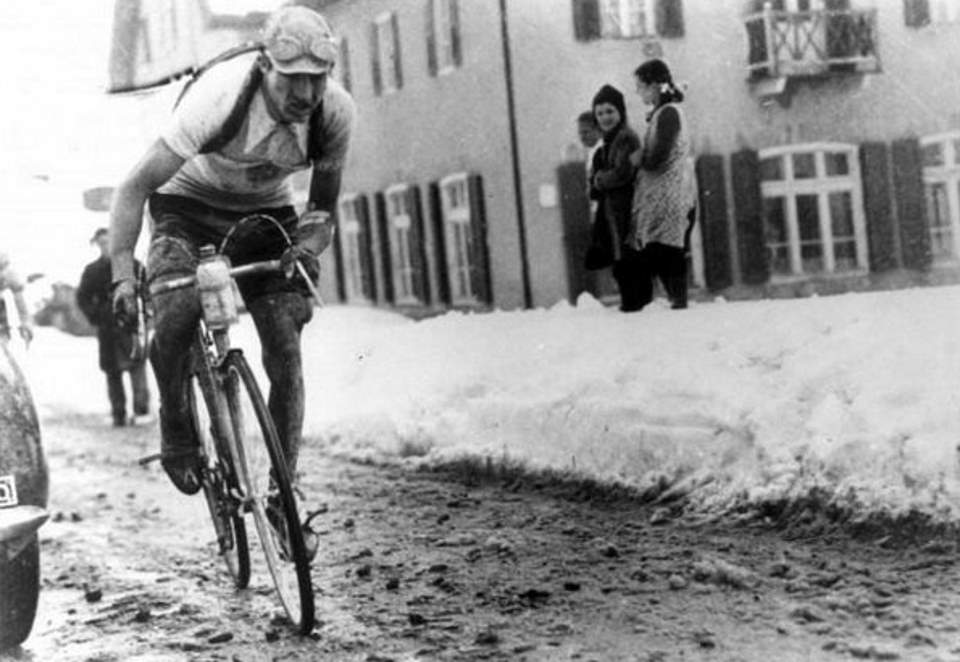
Unlike his biggest rival Fausto Coppi, physically and mentally, Bartali was hard as nails: He was never tired, he was never felt the weather. He always trained and raced with a short-sleeve jersey and a cycling cap only. Stomach troubles beset Coppi from time to time, but the digestive system of the “old man” was a legend in itself. His gregario Giovanni Corriari recalled that “he could eat stones if he wanted”.
Bartali had strong religious beliefs, especially after his brother’s death, and this earned him the nickname “Gino the Pious”.
In September 2013, 13 years after his death, Gino Bartali was recognized as a “Righteous Among the Nations” by Yad Vashem for his efforts to aid Jews during World War II.
Bartali has earned respect for his work in helping Jews who were being persecuted by the Nazis during the time of the Italian Social Republic (Mussolini’s fascist Italy). It emerged in December 2010 that Bartali had hidden a Jewish family in his cellar and, according to one of the survivors, by doing so saved their lives.
Bartali used his fame to carry messages and documents to the Italian Resistance. Bartali cycled from Florence through Tuscany, Umbria, and Marche, sometimes traveling as far afield as Rome, all the while wearing the racing jersey emblazoned with his name. Neither the Fascist police nor the German troops risked discontent by arresting him.
Giorgio Nissim, a Jewish accountant from Pisa, was a member of DELASEM, founded by the Union of the Israelitic Communities to help Jewish Italians escape persecution. The network in Tuscany was discovered in autumn 1943 and all members except Nissim sent to concentration camps. He met Pope Pius XII and, with the help of the Archbishop of Genoa, the Franciscan Friars and others he reorganized DELASEM and helped 800 escape.
Nissim died in 2000. His sons found from his diaries that Bartali had used his fame to help. Nissim and the Oblati Friars of Lucca forged documents and needed photographs of those they were helping. Bartali used to leave Florence in the morning, pretending to train, rode to a convent in which the Jews were hiding, collected their photographs and rode back to Nissim. Bartali used his position to learn about raids on safehouses.
Bartali was eventually taken to Villa Triste in Florence. The SD and the Italian RSS office, Mario Carità questioned Bartali, threatening his life. Bartali simply answered, “I do what I feel [in my heart]”.
Bartali continued with the Assisi Underground. In 1943, he led Jewish refugees towards the Swiss Alps himself. He cycled pulling a wagon with a secret compartment, telling patrols it was just part of his training. Bartali told his son Andrea only that “One does these things and then that’s that”.
In June 2012 a book about Bartali’s wartime activities, Road To Valor by Aili and Andres McConnon, was published. I strongly recommend this book, you can buy it from amazon.
In 2013 Yad Vashem recognized Gino Bartali the title of Righteous Among the Nations. He is a central figure in the 2014 documentary My Italian Secret: The Forgotten Heroes.+
Michele Bartoli
“Leoncino” (Lion Cub)”, “Il Guerriero” (The Warrior)

Michele Bartoli (born 27 May 1970, in Pisa) was one of the best single-day race specialists of his generation, winning three of the five Monument races: Giro di Lombardia (2002, 2003), Liège–Bastogne–Liège (1997, 1998) and Tour of Flanders (1996). He also won the UCI Road World Cup twice, in 1997 and 1998.
[adpost]
Ivan Basso
“Ivan il terribile” (Ivan the terrible), “The Smiling Assassin”
Ivan Basso (born 26 November 1977) was considered among the best climbers in the early 21st century and was considered one of the strongest stage race riders. He is a double winner of the Giro d’Italia, having won the 2006 edition and the 2010 edition of the Italian Grand Tour whilst riding for Team CSC in 2006 and for Liquigas in 2010. He also finished the 2005 Tour de France in 2nd overall, behind Lance Armstrong (Armstrong’s victories between 1999-2005 are annulled, and they were not gifted to the second finishers – there is no “winner” of these races).
Gaetano Belloni
“L’eterno Secondo” (“The Eternal Second”)
Gaetano Belloni (26 August 1892 – 9 January 1980) was an Italian cyclist. He won the 1920 Giro d’Italia, the Milan-San Remo twice (1917, 1920) and the Giro di Lombardia (Currently Il Lombardia) three-time (1915, 1918, 1928). He won a total of 43 races as a professional, including 12 stages at Giro d’Italia.
In the 1920s Belloni constantly rivaled with his friend Costante Girardengo, being almost always defeated and gaining, for this reason, the nickname of “Eterno secondo” (“Eternal second”).
Daniele Bennati
“The Panther”
Daniele Bennati (born 24 September 1980) is an Italian road racing cyclist specializing in fast sprint finishes. He turned professional in 2002, when he joined the team Acqua e Sapone–Cantina Tollo and wore zebra stripes as part of Mario Cipollini’s lead-out train.
Upon joining the Lampre-Caffita team in 2005, he demonstrated the ability to win on his own and has continued to do so since joining Liquigas in 2008. He is an excellent sprinter and has won 11 stages in Grand Tours (two in the Tour de France, three in the Giro d’Italia, and six in the Vuelta a España). He won the points jersey in 2007 Vuelta a España. In 2008 he also won the points jersey in the Giro d’Italia.
He has been nicknamed the panther because his sprint is really elegant and powerful.
Louis Bergaud
“Lily”, “La puce du Cantal”

Louis Bergaud (30 November 1928) is a former French professional road bicycle racer. He won two stages in the Tour de France (1958, 1961). Cantal is a department in south-central France, with its capital at Aurillac.
Charles Berty
“The Ox”
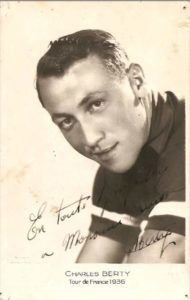
Charles Berty (8 September 1911 – 18 April 1944) was a French cyclist. He broke the 100-kilometer record of France in 1938. The record stood 50 years until broken by Hervé Boussard (8 March 1966 – 26 June 2013). He also broke 6 track records on the same day (16 November 1938) in Milan at the famous Vigorelli velodrome. These records include:
- 70 km
- 80 km
- 90 km
- Two hours
- 40 miles
- 50 miles
He stopped at 93 km due to cold, so he couldn’t break the 100 km record. Interestingly, he never attacked the Hour Record.
Paolo Bettini
“Il Grillo” (The Cricket)
Paolo Bettini (born 1 April 1974 in Cecina, Livorno, Tuscany) is an Italian former (twice) UCI World champion. Considered the best classics specialist of his generation, and probably one of the strongest of all times, he won gold medals in the 2004 Athens Olympics road race and in the 2006 and 2007 World Road Race Championships.
His major wins are UCI World Road Championships (2006, 2007), National Road Race Championships (2003, 2006), Olympic Road Race (2004), Liège–Bastogne–Liège (2000, 2002), Milan–San Remo (2003), Giro di Lombardia (2005, 2006), Clásica San Sebastián (2003), HEW Cyclassics (2003), Züri-Metzgete (2001, 2005). He also won 1 individual stage in the Tour de France, 2 individual stages at the Giro d’Italia and points classification twice (2005, 2006) and 5 individual stages in the Vuelta a España.
Paolo Bettini is nicknamed “Il Grillo” (“the cricket”) for his repeated sudden attacks and his sprinting style.
Antonio Bevilacqua
“Labbrone” (Big lips)
Antonio Bevilacqua (22 October 1918 – 29 March 1972) was an Italian professional road bicycle racer. He won the 1951 Paris–Roubaix.
Marcel Bidot
“The trombone”, “The pack Shepard”
Marcel Bidot (born Paris, France, 21 December 1902, died Saint-Lyé, 26 January 1995) was a French cyclist who won two stages of the Tour de France and became the manager of the French national team. He led the team in 12 Tours and won six of them.
He was nicknamed “The trombone” because of the way he moved around the peloton.
[adpost]
Alfredo Binda
“Campionissimo” (Champion of champions), “Trombettiere di Cittiglio” (The Trumpeter of Cittiglio), Giocondo (from the Mona Lisa because of his amiability)
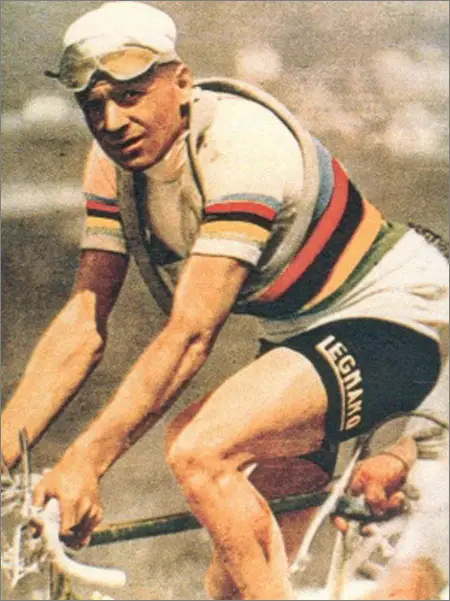
Alfredo Binda (11 August 1902 – 19 July 1986) was the best Italian cyclist of the 1920s and 1930s, and also one of the best cyclists of all time. He was the first to win five editions of the Giro d’Italia, and a three-time world champion. In addition, he won Milan–San Remo twice, and the Giro di Lombardia four times.
His dominance in the Giro was overwhelming: besides the five overall victories, he won 41 stages (a record only broken in 2003 by Mario Cipollini). In 1927, he won 12 out of 15 stages, and in 1929 he won 8 consecutive stages. Because of this domination, he was offered money not to compete in the Giro of 1930. Instead, he took part in that year’s Tour de France, winning two stages.
Later he would manage the Italian National team. Under him, Fausto Coppi, Gino Bartali and Gastone Nencini all triumphed at the Tour de France.
He was a trained trumpet player and was nicknamed “Trombettiere di Cittiglio” (“The Trumpeter of Cittiglio”).
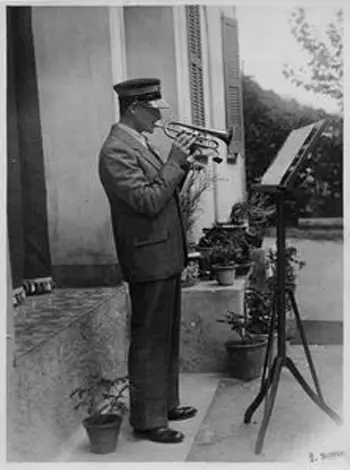
Franco Bitossi
“Cuore matto” (Crazy heart)
Franco Bitossi was born on 1 September 1940 in Camaioni di Carmignano, Italy. He cycled for three years as an amateur and became a professional in October 1961, after he had reached the required age of 21. As a professional cyclist, from 1961 until 1978, he won a total of 171 races.
In 1965 he won the Tour de Suisse and the Züri-Metzgete, which he won again in 1968. In 1967 he won the Tirreno–Adriatico, Giro di Lombardia and Coppa Agostoni, while the following year he became the first Italian to win the points classification in the Tour de France. In 1970, he won the Italian championship. In 1972 he became famous for his near-victory at the World Championship in Gap, France, where he was beaten by only a few meters by his teammate Marino Basso. Four years later, in 1978, he won the Italian Championship again.
Bitossi was nicknamed “Cuore matto” (Crazy heart) due to a cardiac arrhythmia which often compelled him to stop midway in a stage.
Olimpio Bizzi
“Il Morino di Livorno” (The Morino from Livorno)
Olimpio Bizzi (1 August 1916 Livorno – 3 August 1976 Abetone) was an Italian cyclist, who won 13 stages of Giro d’Italia in 1936–1946, as well as the 1950 Tour du Maroc. He rode the 1947 Tour de France, and placed sixth in the 1947 Paris–Roubaix.
He was nicknamed “Il Morino di Livorno”. In Italian, Morino is the pet form of the medieval personal name and nickname “Moro” (English: Moor).
[adpost]
Louison Bobet
“Louison”, “Zonzon”
Louis “Louison” Bobet (12 March 1925 – 13 March 1983) was the first great French rider of the post-war period and the first rider to win the Tour de France in three successive years, from 1953 to 1955. His career included the national road championship (1950 and 1951), Milan–San Remo (1951), Giro di Lombardia (1951), Critérium International (1951 & 52), Paris–Nice (1952), Grand Prix des Nations (1952), world road championship (1954), Tour of Flanders (1955), Critérium du Dauphiné Libéré (1955), Tour de Luxembourg (1955), Paris–Roubaix (1956) and Bordeaux–Paris (1959).
In 1950 he won the national championship at Montlhéry south of Paris the week before the Tour and rode in the national team with Raphaël Géminiani, the rider who had beaten him as a boy in Premier Pas Dunlop. He and Bobet developed a rocky friendship, Géminiani’s rough, instinctive character a contrast to the more thoughtful, quieter Bobet. The two argued frequently but remained friends. Géminiani, following the French habit of creating nicknames by doubling a syllable of a name, referred to Bobet as “Zonzon”, a name that Bobet hated but tolerated.
Tom Boonen
“Tommeke”, “Tornado Tom”, “Bom van Balen” (The Bomb from Balen)
Tom Boonen is a single-day road specialist with a strong finishing sprint. He won the cycling monuments Paris–Roubaix 4 times and the Tour of Flanders 3 times, among many other prestigious victories, such as prevailing 5 times in the E3 Harelbeke, winning 6 stages of the Tour de France and winning the Overall title of the Tour of Qatar 4 times. He is also the 2005 UCI world road race champion.
[adpost]
Ottavio Bottecchia
“Le Maçon de Frioul” (The mason from Friuli), “Butterfly”
Ottavio Bottecchia (1 August 1894 – 15 June 1927) was an Italian cyclist and the first Italian winner of the Tour de France. He won the Tour twice (1924, 1925), along with 9 individual stages (1923, 1924, 1925).
Bottecchia was born as the eighth child of a poor family of nine children. He went to school for just a year, first working as a shoemaker, then as a bricklayer, that’s why he earned the nickname “Le Maçon de Frioul” (The mason from Friuli). His ears stuck out so far that the Tour organizer, Henri Desgrange referred to him as “butterfly”.
On 15 June 1927, he was found dead by the roadside; the reason remains a mystery.
Hernán Buenahora
“El Cabrito de Barichara” (The Little Goat from Barichara)
Hernán Buenahora Gutíerrez (born March 18, 1967, in Barichara, Santander) is a Colombian road racing cyclist, who was nicknamed El Cabrito de Barichara (The Little Goat from Barichara) during his career.
Sources
- Federico Bahamontes on Wikipedia
- Ercole Baldini on Wikipedia
- Gino Bartali on Wikipedia
- Fallen Angel: The Passion of Fausto Coppi; Fotheringham W.; Yellow Jersey Press; London
- Ivan Basso on Wikipedia
- Gaetano Belloni on Wikipedia
- Daniele Bennati on Wikipedia
- Paolo Bettini on Wikipedia
- Franco Bitossi on Wikipedia
- Louison Bobet on Wikipedia
- Ottavio Bottecchia on Wikipedia
- Top 18 fastest Paris-Roubaix editions - April 7, 2024
- Col de Tourmalet [Amazing photo from the 1953 Tour de France] - January 11, 2024
- Bernard Hinault and Francesco Moser, 1981 Paris-Roubaix - December 8, 2023
